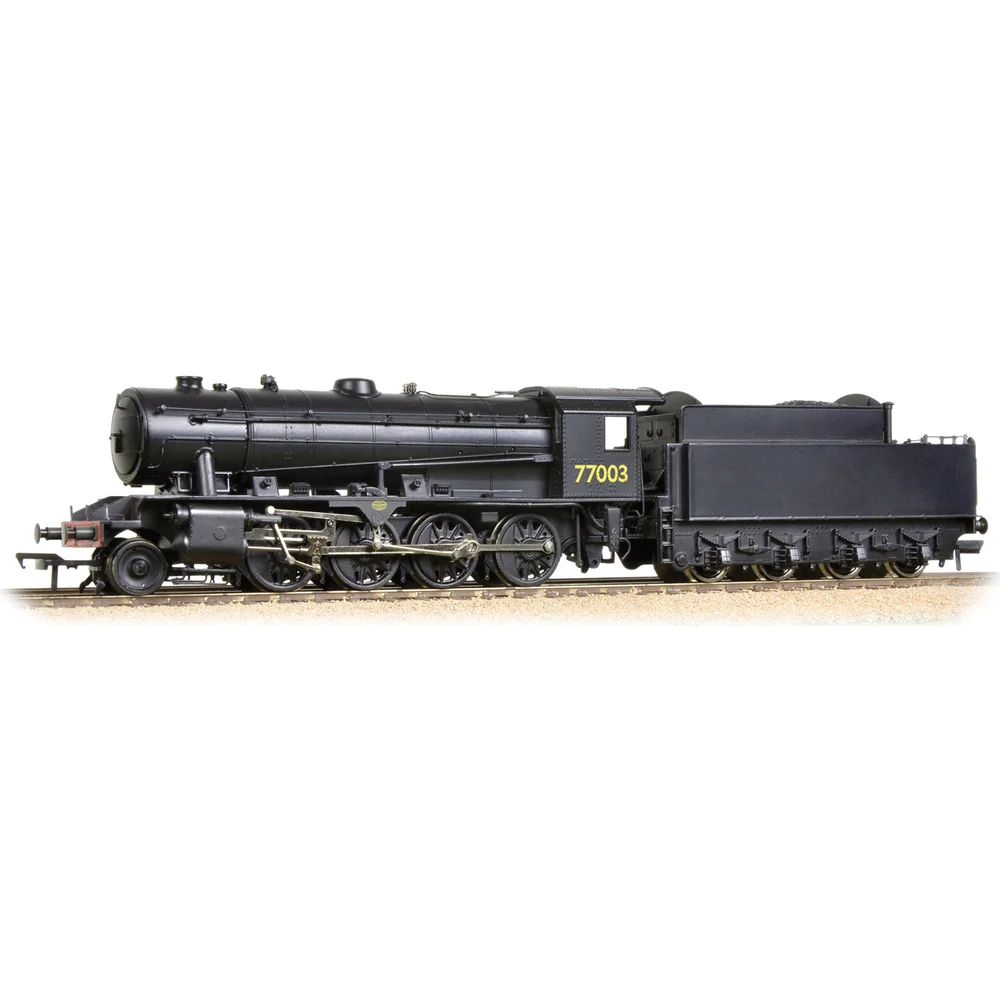Bachmann 32-254A
War Department Austerity 2-8-0 77003 London & North Eastern Railway Black
Tooling
In 2012, Bachmann Branchline released a significantly upgraded version of its OO gauge War Department Austerity 2-8-0. This retooling replaced the original 1996 tooling and addressed many of the limitations of the earlier model, aligning it with contemporary expectations for detailing, performance, and digital control. The upgrade was part of Bachmann’s ongoing effort to modernise its range and improve fidelity to prototype and operational standards.
Tooling Features
- Scale: OO gauge (1:76)
- Construction: Plastic bodyshell with separately fitted fine details; metal chassis
- Detailing: Factory-fitted handrails, lamp irons, pipework, smokebox door dart, safety valves, cab interior, and etched nameplates on select models
- Couplings: NEM pockets with tension-lock couplers; sprung buffers
Mechanical & Electrical
- Motor: 3-pole motor located in the locomotive
- Drive: Loco-driven wheels with all-wheel pickup
- Minimum Radius: Compatible with second radius curves (approx. 438mm)
- Lighting: Directional lighting on some models; provision for lamps via decoder functions
- Weighting: Balanced weight distribution in loco and tender for improved traction
DCC Capability
The 2012 tooling introduced full DCC readiness with a 21-pin socket located in the tender. This allowed for straightforward decoder installation and enabled sound-fitted versions using ESU LokSound V5 decoders. Models with sound included a wide range of functions such as playable whistles, injectors, firebox door effects, and shunting mode.
Liveries Produced
Several liveries were produced using the 2012 tooling, including:
- Longmoor Military Railway Blue
- LNER Black
- BR Black (early and late crests)
- War Department Khaki
Reviews
Reviews of the retooled model were generally positive. Enthusiasts praised the improved detailing, smoother running, and ease of DCC installation. Sound-fitted versions received particular acclaim for their immersive audio experience. Some users noted minor issues with tight body fitting and occasional short circuits when reassembling, typically resolved with careful insulation.
Media & Commentary
The upgraded model has been featured in numerous YouTube reviews and layout showcases. Social media commentary highlights the model’s improved realism and performance, with many users considering it a worthwhile upgrade over the original tooling. Forum discussions often compare the new version favourably to other contemporary releases, especially in terms of finish and sound quality.
Additional Notes
- Accessory packs included additional pipework and bufferbeam details
- Removable coal load with modelled coal space beneath
- Some models included adjustable tender drawbars for closer coupling
- Sound-equipped models supported analogue operation with automatic sound playback
Class & Prototype
- Class: War Department Austerity 2-8-0
- Traction: Steam
- Built: 1943-1945
- Total Built: 935
- Running Number: 77003
Operator & Livery
- Operator: London & North Eastern Railway
- Livery: Black
- Era: 3 - The big 4 – LMS, GWR, LNER & SR
The London & North Eastern Railway emerged in 1923 as Britain's second-largest railway company, combining seven major railways including the Great Northern, North Eastern, and Great Eastern into a 6,590-mile network stretching from London's four terminals to the Scottish Highlands. Despite serving economically challenged industrial regions, the LNER achieved worldwide recognition for engineering excellence and speed records that remain unbroken today.
Under Chief Mechanical Engineers Sir Nigel Gresley, Edward Thompson, and Arthur Peppercorn, the LNER developed revolutionary locomotive designs characterised by three-cylinder layouts and streamlined aesthetics. Gresley's masterpieces included the A1 Pacifics featuring Flying Scotsman and the legendary A4 class, culminating in Mallard's world steam speed record of 126 mph in 1938.
The company pioneered luxury express services including the Silver Jubilee and Coronation streamliners, whilst investing in forward-thinking electrification schemes and massive marshalling yards. Notable achievements included operating the complete East Coast Main Line, introducing Britain's first regular 400-mile non-stop service, and commissioning Eric Gill's iconic typography that influenced railway design for decades.
Nationalised in 1948, LNER locomotives continued serving British Railways until the 1960s, with some A4 Pacifics working Scottish expresses until 1966. Today, the LNER's engineering legacy thrives through extensive preservation, new-build projects like Tornado, and comprehensive model ranges covering every major class in all popular scales, making LNER subjects essential for discerning railway modellers seeking authentic British steam-age atmosphere.
The LNER plain black livery emerged as a practical economy measure that ultimately became the most widely applied colour scheme in the company's history. Initially introduced for goods engines in 1928 to reduce painting costs and labour time, this austere unlined black finish dispensed with decorative red lining whilst retaining the basic yellow lettering and "L N E R" tender markings. The livery reflected the harsh economic realities facing the LNER, particularly as the company served Britain's struggling industrial regions during the depression years of the 1930s.
The plain black scheme reached its zenith during World War II when, from 1941 onwards, austerity measures mandated that all locomotive classes receive unlined black paint regardless of their previous prestigious liveries. The transformation was dramatic – even the magnificent streamlined A4 Pacifics like Mallard and Flying Scotsman were painted in stark black, their elegant engineering unchanged but their glamorous appearance replaced by wartime utility. The austerity deepened in October 1943 when tender lettering was reduced from "L N E R" to simply "N E", halving material usage and painting time whilst creating one of the most recognisable images of Britain's wartime railways. For modellers, this livery authentically represents the challenging economic and wartime periods, offering dramatic visual impact and historical accuracy when depicting late 1920s freight operations, 1930s depression-era scenes, or the austere years of 1941-1947 when Britain's railways prioritised function over form.
